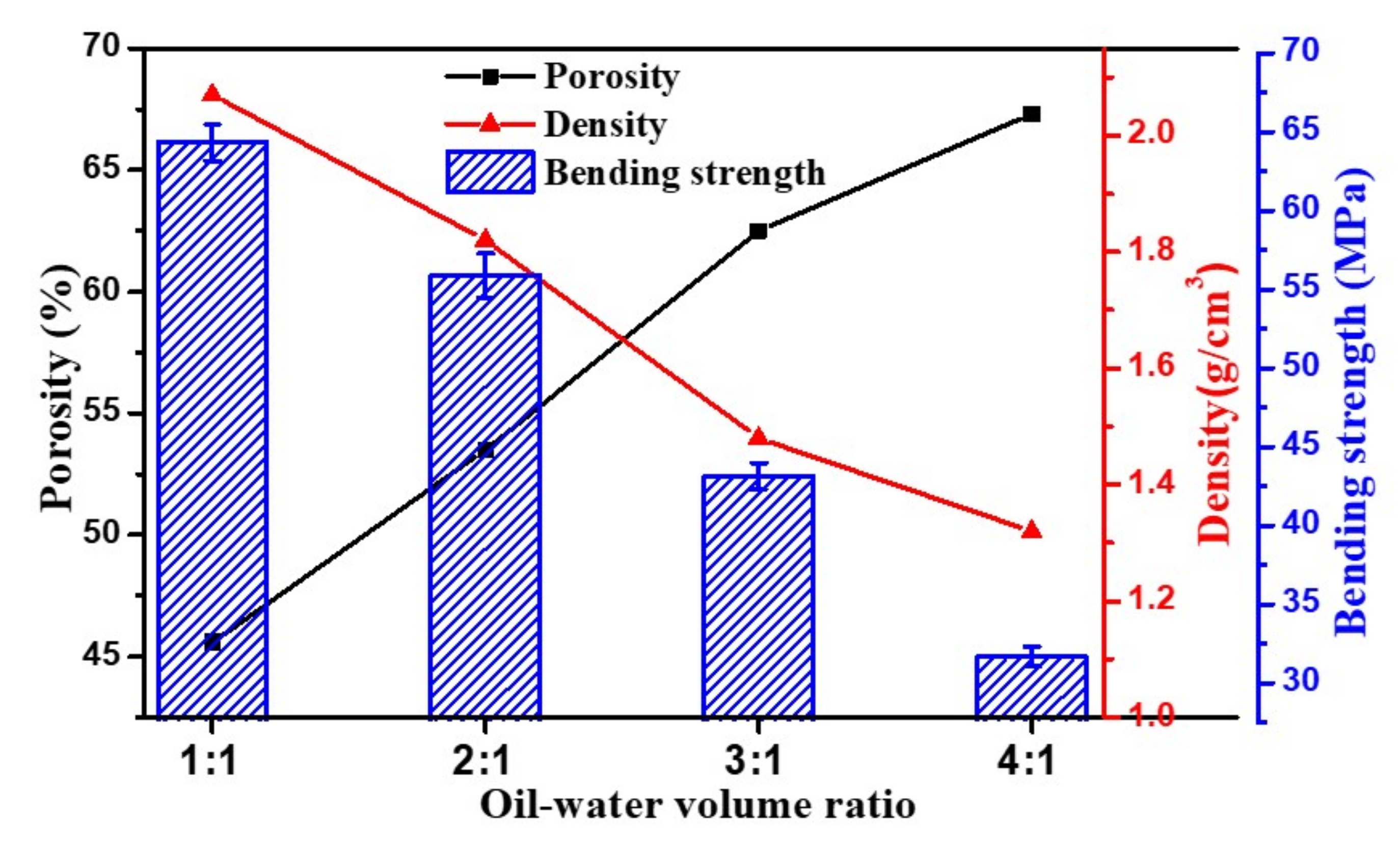Novel Fabrication Processing of Porous Al2O3/CaAl12O19 Membrane by Combining Emulsion, Cement Curing and Tape-Casting Methods
Abstract
:1. Introduction
2. Materials and Experimental
3. Results and Discussion
4. Conclusions
Author Contributions
Funding
Institutional Review Board Statement
Informed Consent Statement
Data Availability Statement
Conflicts of Interest
References
- Cha, M.; Kim, S.; Park, C. Recent advances and future potential of anaerobic ceramic membrane bioreactors for wastewater treatment: A review. Membr. Water Treat. 2020, 11, 31–39. [Google Scholar]
- Abadikhah, H.; Ashtiani, F.Z.; Fouladitajar, A. Nanofiltration of oily wastewater containing salt; experimental studies and op-timization using response surface methodology. Desalin. Water Treat. 2015, 56, 2783–2796. [Google Scholar]
- Wang, F.; Gu, H.; Yin, J.; Xia, Y.; Zuo, K.; Liang, H.; Ning, C.; Yao, D.; Zeng, Y. Porous Si3N4 fabrication via volume-controlled foaming and their sound absorption properties. J. Alloys Compd. 2017, 727, 163–167. [Google Scholar] [CrossRef]
- Dong, B.; Yang, M.; Wang, F.E.; Wang, J.; Hao, L.; Xu, X.; Wang, G.; Agathopoulos, S. Production and characterization of durable self-cleaning and engineering porous Al2O3/CaAl12O19 ceramic membranes. J. Am. Ceram. Soc. 2019, 102, 3879–3886. [Google Scholar] [CrossRef]
- Li, J.; Yuan, W.; Deng, C.; Zhu, H. Porous SiC/SiCN composite ceramics fabricated by foaming and reaction sintering. J. Eur. Ceram. Soc. 2017, 37, 1131–1134. [Google Scholar] [CrossRef]
- Jana, D.C.; Sundararajan, G.; Chattopadhyay, K. Effect of Porosity on Structure, Young’s Modulus, and Thermal Conductivity of SiC Foams by Direct Foaming and Gel casting. J. Am. Ceram. Soc. 2017, 100, 312–322. [Google Scholar] [CrossRef]
- Song, J.; Zhang, Z.; Tang, S.; Tan, Y.; Zhang, X. Does pre-ozonation or in-situ ozonation really mitigate the protein-based ceramic membrane fouling in the integrated process of ozonation coupled with ceramic membrane filtration? J. Membr. Sci. 2018, 548, 254–262. [Google Scholar] [CrossRef]
- Guo, Q.; Xiang, H.; Sun, X.; Wang, X.; Zhou, Y. Preparation of porous YB4 ceramics using a combination of in-situ borothermal reaction and high temperature partial sintering. J. Eur. Ceram. Soc. 2015, 35, 3411–3418. [Google Scholar] [CrossRef]
- Prenzel, T.; Döge, K.; Motta, R.P.O.; Wilhelm, M.; Rezwan, K. Controlled hierarchical of hybrid ceramics by leaching water soluble templates and pyrolysis. J. Eur. Ceram. Soc. 2014, 34, 1501–1509. [Google Scholar] [CrossRef]
- Dong, B.; Wang, F.; Yu, J.; Abadikhah, H.; Khan, S.; Yang, M.; Hao, L.; Xu, X.; Wang, G.; Agathopoulos, S. Porous calcium hex-aluminate planar membrane with a high morphological stability and a low thermal conductivity. J. Eur. Ceram. Soc. 2019, 39, 4202–4207. [Google Scholar] [CrossRef]
- Dong, B.; Wang, L.; Min, Z.; Wang, Q.; Yin, C.; Jia, T.; Wang, Y.; Zheng, X.; Wang, F.; Abadikhah, H.; et al. Fabrication of novel porous Al2O3 substrates by combining emulsion templating and gel-tape-casting methods. Ceram. Int. 2022, 48, 7320–7324. [Google Scholar] [CrossRef]
- Han, L.; Li, F.; Deng, X.; Wang, J.; Zhang, H.; Zhang, S. Foam-gelcasting preparation, microstructure and thermal insulation performance of porous diatomite ceramics with hierarchical pore structures. J. Eur. Ceram. Soc. 2017, 37, 2717–2725. [Google Scholar] [CrossRef]
- Dong, B.; Wang, G.; Yuan, B.; Han, J.; Chen, K.; Li, H. Fabrication and properties of porous alumina ceramics with three different pore sizes. J. Porous Mater. 2017, 24, 805–811. [Google Scholar] [CrossRef]
- Jakobs, E.; Koros, W. Ceramic membrane characterization via the bubble point technique. J. Membr. Sci. 1997, 124, 149–159. [Google Scholar] [CrossRef]
- Li, L.; Wang, J.; Zhong, H.; Hao, L.; Abadikhaha, H.; Xu, X.; Chen, X.; Agathopoulos, S. Novel α-Si3N4 planar nanowire super-hydrophobic membrane prepared through in-situ nitridation of silicon for membrane distillation. J. Membr. Sci. 2017, 543, 98–105. [Google Scholar] [CrossRef]
- Ukrainczyk, N. Kinetic modeling of calcium aluminate cement hydration. Chem. Eng. Sci. 2010, 65, 5605–5614. [Google Scholar] [CrossRef]
- Zhang, Y.; Li, N.; Yan, W. Effect of sulfur on the ion concentration of pore solution and the hydration of calcium aluminate cement. Cem. Concr. Compos. 2015, 62, 76–81. [Google Scholar] [CrossRef]
- Sarpoolaky, H.; Ahari, K.; Lee, W. Influence of in situ phase formation on microstructural evolution and properties of castable refractories. Ceram. Int. 2002, 28, 487–493. [Google Scholar] [CrossRef]




Publisher’s Note: MDPI stays neutral with regard to jurisdictional claims in published maps and institutional affiliations. |
© 2022 by the authors. Licensee MDPI, Basel, Switzerland. This article is an open access article distributed under the terms and conditions of the Creative Commons Attribution (CC BY) license (https://creativecommons.org/licenses/by/4.0/).
Share and Cite
Wang, L.; Dong, B.; Min, Z.; Guan, L.; Zheng, X.; Wang, Q.; Yin, C.; Zhang, R.; Wang, F.; Abadikhah, H.; et al. Novel Fabrication Processing of Porous Al2O3/CaAl12O19 Membrane by Combining Emulsion, Cement Curing and Tape-Casting Methods. Membranes 2022, 12, 747. https://doi.org/10.3390/membranes12080747
Wang L, Dong B, Min Z, Guan L, Zheng X, Wang Q, Yin C, Zhang R, Wang F, Abadikhah H, et al. Novel Fabrication Processing of Porous Al2O3/CaAl12O19 Membrane by Combining Emulsion, Cement Curing and Tape-Casting Methods. Membranes. 2022; 12(8):747. https://doi.org/10.3390/membranes12080747
Chicago/Turabian StyleWang, Li, Binbin Dong, Zhiyu Min, Li Guan, Xichen Zheng, Qingfeng Wang, Chaofan Yin, Rui Zhang, Feihong Wang, Hamidreza Abadikhah, and et al. 2022. "Novel Fabrication Processing of Porous Al2O3/CaAl12O19 Membrane by Combining Emulsion, Cement Curing and Tape-Casting Methods" Membranes 12, no. 8: 747. https://doi.org/10.3390/membranes12080747
APA StyleWang, L., Dong, B., Min, Z., Guan, L., Zheng, X., Wang, Q., Yin, C., Zhang, R., Wang, F., Abadikhah, H., Xu, X., Wang, G., Yuan, B., & Yang, D. (2022). Novel Fabrication Processing of Porous Al2O3/CaAl12O19 Membrane by Combining Emulsion, Cement Curing and Tape-Casting Methods. Membranes, 12(8), 747. https://doi.org/10.3390/membranes12080747




